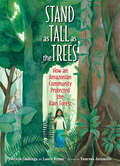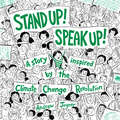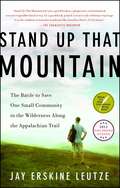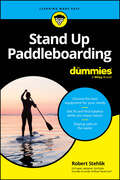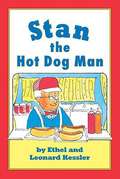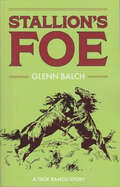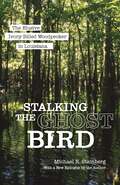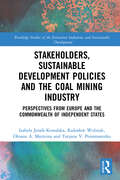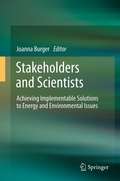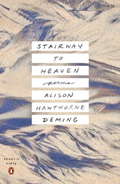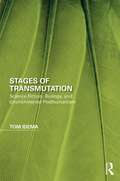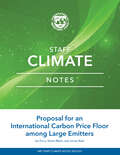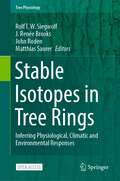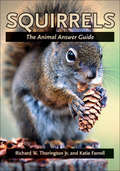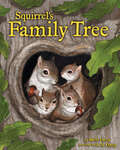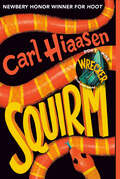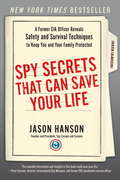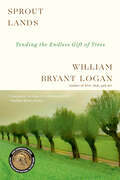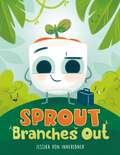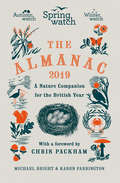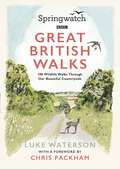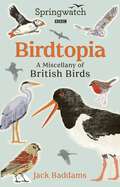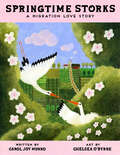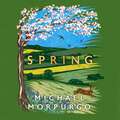- Table View
- List View
Stand as Tall as the Trees: How an Amazonian Community Protected the Rain Forest
by Laura Resau Patricia GualingaAn inspiring true story about how an activist in the Amazon worked with other Indigenous communities to protect and preserve their sacred lands and forests.Patricia (Paty) Gualinga grew up in her Kichwa village in the Amazon of Ecuador where mystical beings called Amazanga help protect the forest. Paty traveled away from home for school until she was called back—companies that said the government sold them property were destroying her people&’s lands to look for oil. The Kichwa community worked with other Indigenous groups to bring the Ecuadorian government to the Court of Human Rights.Lyrically told and beautifully illustrated, this moving story will remind readers of the importance of nature conservation, perseverance, and standing up for your community.&“A gorgeously told true story, full of lyricism, wonder, beautiful artwork, and most importantly, HOPE. Stand as Tall as the Trees makes my heart swell every time I read it. We need more stories like this—in life and in our libraries.&” —Todd Mitchell, Green Earth Book Award Honor Winner and Author of The Namer of Spirits&“This moving and inspirational story of Patricia Gualinga's fight for her community's Amazon rainforest is an urgent call to action to protect the wilderness, which, in the poignant words of the authors, keeps us all alive. Stand as Tall as the Trees is an ode to the power of ordinary people to affect change. Lovingly written and illustrated, it is a book that will inspire a new generation of activists.&”—Lea Aschkenas, bilingual librarian and author of Arletis, Abuelo, and the Message in a Bottle &“This picture book will capture your heart and imagination alike.&”– Alda P. Dobbs, Winner of the Pura Belpré Honor Award and Author of The Other Side of the River&“This gorgeous book will surely delight youngsters, but it will be on my syllabus for graduate students studying Nature Writing as well. After all, books for younger readers influence our cultural conversation about the environment. Who doesn&’t remember their favorite nature-based picture book? I think we all do, because they were seared into our brains at a powerful moment. This book deserves to be one of those memorable classics, worth studying for its important story, delightful art, inclusion, and environmental ethic.&”—Laura Pritchett, PhD, Director of the MFA in Nature Writing at Western Colorado University and PEN USA Award Winning Author"A true story full of wisdom and hope, this book's stunning beauty ranges from the gorgeous illustrations to the powerful messages of bravery, strength, and perseverance. Stand as Tall as the Trees is a poetic and soulful gem that offers inspiration for readers of all ages."— Bailey Cates, NYT bestselling author
Stand Up! Speak Up!: A Story Inspired by the Climate Change Revolution
by Andrew JoynerAwarded as a 2021 Malka Penn Award Honor Book, here is a timely picture book about a young girl's mission to inspire others to help the planet. The meaningful message of climate change activism is perfect for Earth Day and every day! Celebrate young climate change activists in this charming story about an empowered girl who shows up, listens up, and ultimately, speaks up to inspire her community to take action against climate change. After attending a climate march, a young activist is motivated to make an effort and do her part to help the planet... by organizing volunteers to work to make green changes in their community, from cleaning a lake, to planting trees, to making composting bins, to hosting a clothing swap and more! Here is an uplifting picture book that is an important reminder that no change is too small--and no person is too young--to make a difference.With simple text and lively illustrations, Andrew Joyner has given young children a timely story about activism, community, and hope.
Stand Up That Mountain
by Jay Erskine LeutzeIn the tradition of A Civil Ac tion--the true story of a North Carolina outdoorsman who teams up with his Appalachian "mountain people" neighbors to save treasured land from being destroyed Living alone in his wooded mountain retreat, Jay Leutze gets a call from a whip-smart fourteen-year-old, Ashley Cook, and her aunt, Ollie Cox, who say a mining company is intent on tearing down Belview Mountain, the towering peak above their house. Ashley and her family, who live in a little spot known locally as Dog Town, are "mountain people," with a way of life and speech unique to their home high in the Appalachians. They suspect the mining company is violating the law, and they want Jay, a nonpracticing attorney, to stop the destruction of the mountain. Jay, a devoted naturalist and fisherman, quickly decides to join their cause. So begins the epic quest of the "Dog Town Bunch," a battle that involves fiery public hearings, clandestine surveillance of the mine operator's activities, ferocious pressure on public officials, and high-stakes legal brinksmanship in the North Carolina court system. Jay helps assemble a talented group of environmental lawyers to do battle with the well-funded attorneys protecting the mining company's plan to dynamite Belview Mountain, which happens to sit next to the famous Appalachian Trail, the 2,184-mile national park that stretches from Maine to Georgia. As the mining company continues to level the forest and erect a gigantic rock-crushing plant on the site, Jay's group searches frantically for a way to stop an act of environmental desecration that will destroy a fragile wild place and mar the Appalachian Trail forever. Much more than the record of a legal battle, Stand Up That Mountain takes the reader to a remote corner of Appalachia, a region often stereotyped and little understood, even now in the twenty-first century. A naturally elegant writer, Jay Leutze delivers a powerful, beautifully written story full of remarkable characters, such as "Wingfoot," an elusive protector of the Appalachian Trail; a stubborn mining company engineer intent on pulling down the mountain in the face of intense opposition; and Ron Howell, a retired and legendary North Carolina Superior Court judge known as the "Heel Hound" for his relentless pursuit of legal victory. Jay's plaintiff group is eventually joined by several national conservation groups who see that Belview Mountain and the Appalachian Trail must be protected for future generations of Americans. A great contemporary story that demonstrates what is possible when local people set their minds to righting a local wrong, Stand Up That Mountain will appeal to conservationists, hikers, attorneys, and readers fascinated by Appalachia and rural life, and anyone interested in a compelling story both well told and true.
Stand Up Paddleboarding For Dummies
by Robert StehlikAn easy and accessible guide for one of the fastest growing water sports in the world Looking for a way to get some exercise out on the water and have a blast while you're at it? Then it's time to try stand up paddleboarding! Stand Up Paddleboarding For Dummies walks you through absolutely everything you need to know to get started with this fun, exciting, and healthy activity. It's packed with illustrations, graphics, and easy-to-understand tips that make it a snap to do everything from choosing your first board to respecting the marine life you'll see while you're in the water. This book will prepare you for your new hobby so you can feel safe, knowledgeable, and comfortable with the ins and outs of this rapidly growing sport. You'll also find: Essential safety tips, including how to maintain your balance on the board and helpful stretches you can do before and after your next stand up paddleboarding session A list of common rookie mistakes—and how to avoid them—so you can get a head start on your new pastime Equipment basics that will help you choose the gear that's right for you on your first try Stand Up Paddleboarding For Dummies is a great book for people ready to take on a cool and healthy new activity, as well as the perfect gift for that active and fun-loving person in your life who can't get enough of being out on the water. Grab a copy today!
Stan the Hot Dog Man
by Leonard Kessler Ethel KesslerAfter he retires, Stan becomes a hot dog man and finds that his new job helps him come to the rescue during a big snowstorm.
Stallion's Foe (Tack Ranch #8)
by Glenn BalchBen Darby and his younger sister Dixie are out inspecting the wild horses near their father’s ranch when they discover that King, a big, wild black stallion owned by their friend Andy Blair and carefully watched by Ben and Dixie, is missing from his band of wild horses. Knowing he would never leave his group, the two begin a quest to find and return King to the mares and foals that run with him. But the quest is long, and when they find King, he is nearly dead. Can the boy and his sister, working with their father and others, save the beautiful big stallion? Will King lead his band of wild horses again?
Stalking the Ghost Bird: The Elusive Ivory-Billed Woodpecker in Louisiana
by Michael K. SteinbergWhen a kayaker thought he spotted an ivory-billed woodpecker in 2004, the birding community took notice. Two birders traveled to the bayou where the sighting occurred, well aware that the last confirmed sighting of an ivory-bill had taken place over sixty years ago. Both men caught a glimpse of the bird, and a team began to search the surrounding swamplands. Even after long hours of surveillance and multiple sightings, the scientists cautiously refused to disclose their rediscovery of the extinct bird until they captured it on film. At last, armed with a short video and sound clip, they published their findings in Science, triggering a frenzy of media coverage and sparking a controversy among birders and scientists who continue to disagree about whether the bird really still exists.In Stalking the Ghost Bird, Michael K. Steinberg engages the lengthy debate over the ivory-bill's status by examining the reported sightings and extensive efforts to find the rare bird in Louisiana. Louisiana has long been at the center of the ivory-bill's story. John James Audubon wrote about the bird and its habitat during his stay in St. Francisville, and scientists James Tanner and George Lowery studied the ivory-bill in Louisiana in the 1930s and 1940s. More recently, bird experts have conducted targeted searches in Louisiana. Steinberg discusses these and other scientific expeditions, and he catalogs reported ivory-bill sightings since the 1950s, using a detailed timeline that includes both dates and specific locations.Interviews with conservation officials, ornithologists, and native Louisianans illuminate the ongoing controversy and explore why the ivory-bill, more than any other bird, arouses so much attention. Steinberg meets elderly residents of the Atchafalaya Basin who saw the ivory-bill while hunting in the 1930s and even ate the bird-which they called the "forest turkey"-during hard times. He paddles into Two O'Clock Bayou with one wildlife professor and travels to a cypress-filled wildlife refuge with the director of Louisiana's Nature Conservancy. His interviews illustrate how expert opinions vary, as well as how much local non-experts know.Steinberg also explores in detail the human impact on both the ivory-bill and its bottomland forest habitat, explains how forest-management practices in the South may pose problems for an ivory-bill recovery, and outlines where future searches for the bird should take place. In this absorbing study, Steinberg turns his lifelong interest in the majestic ivory-billed woodpecker into a tale that encapsulates both the mystery and intrigue surrounding the legendary bird and our fascination with it.
Stakeholders, Sustainable Development Policies and the Coal Mining Industry: Perspectives from Europe and the Commonwealth of Independent States (Routledge Studies of the Extractive Industries and Sustainable Development)
by Izabela Jonek-Kowalska Radosław Wolniak Oksana A. Marinina Tatyana V. PonomarenkoThis book identifies the impact of internal and external stakeholders on the implementation of sustainable development policies in the coal mining sector in Europe and the Commonwealth of Independent States. The book assesses what activities and conditions need to be improved so that sustainable development policies can be more effectively and efficiently implemented. With a specific focus on the hard coal and lignite mining sectors, it examines a broad range of case studies from Eastern European countries and the Commonwealth of Independent States, including Russia, Ukraine, Poland, Kazakhstan, Germany, Spain, France and the United Kingdom, among many more. Beginning with an introduction to sustainable development and stakeholder theory, Part II then examines internal stakeholders, including owners, managers, employees and trade unions. Part III examines external stakeholders, touching upon those directly related to the mining industry, such as customers and mining enterprises, and those not directly associated such as local and regional communities and environmental organisations. The book concludes by proposing a model approach to the management of stakeholders involved in mining enterprises, focusing on improving the process of implementing sustainable development in the mining sector and strengthening the effects of this process. This book will be of great interest to students and scholars of the extractive industries, natural resource management and policy and sustainable development.
Stakeholders and Scientists
by Joanna BurgerNation and the World must move forward with development of a range of energy sources and savings, all with attendant environmental problems. Solving these problems, and those remaining from past energy-related activities, will require iteration, inclusion, and collaboration with a wide range of stakeholders, including U.S., State and local governmental agencies, Tribal Nations, scientists, environmentalists, public policy makers, and the general public.
Stairway to Heaven: Poems
by Alison DemingA new collection from a poet who "writes with scrupulous and merciful passion about every kind of relatedness--family, place, politics, and wildlife" (W. S. Piero)In her fifth book of poems, Stairway to Heaven, Alison Hawthorne Deming explores dimensions of grief and renewal after losing her brother and mother. Grounded in her communion with nature and place, she finds even in Death Valley, that most stark of landscapes, a spirit of inventiveness that animates the ground we walk on. From the cave art of Chauvet to the futuristic habitat of Biosphere 2, that inventiveness becomes consolation for losses in family and nature, a means to build again a sense of self and world in the face of devastating loss.From the Trade Paperback edition.
Stages of Transmutation: Science Fiction, Biology, and Environmental Posthumanism (Perspectives on the Non-Human in Literature and Culture)
by Tom IdemaStages of Transmutation: Science Fiction, Biology, and Environmental Posthumanism develops the theoretical perspective of environmental posthumanism through analyses of acclaimed science fiction novels by Greg Bear, Octavia Butler, Kim Stanley Robinson, and Jeff VanderMeer, in which the human species suddenly transforms in response to new or changing environments. Narrating dramatic ecological events of human-to-nonhuman encounter, invasion, and transmutation, these novels allow the reader to understand the planet as an unstable stage for evolution and the human body as a home for bacteria and viruses. Idema argues that by drawing tension from biological theories of interaction and emergence (e.g. symbiogenesis, epigenetics), these works unsettle conventional relations among characters, technologies, story-worlds, and emplotment, refiguring the psychosocial work of the novel as always already biophysical. Problematizing a desire to compartmentalize and control life as the property of human subjects, these novels imagine life as an environmentally mediated, staged event that enlists human and nonhuman actors. Idema demonstrates how literary narratives of transmutation render biological lessons of environmental instability and ecological interdependence both meaningful and urgent—a vital task in a time of mass extinction, hyperpollution, and climate change. This volume is an important intervention for scholars of the environmental humanities, posthumanism, literature and science, and science and technology studies.
Stable Isotopes in Tree Rings: Inferring Physiological, Climatic and Environmental Responses (Tree Physiology #8)
by Rolf T. W. Siegwolf J. Renée Brooks John Roden Matthias SaurerThis Open Access volume highlights how tree ring stable isotopes have been used to address a range of environmental issues from paleoclimatology to forest management, and anthropogenic impacts on forest growth. It will further evaluate weaknesses and strengths of isotope applications in tree rings. In contrast to older tree ring studies, which predominantly applied a pure statistical approach this book will focus on physiological mechanisms that influence isotopic signals and reflect environmental impacts. Focusing on connections between physiological responses and drivers of isotope variation will also clarify why environmental impacts are not linearly reflected in isotope ratios and tree ring widths. This volume will be of interest to any researcher and educator who uses tree rings (and other organic matter proxies) to reconstruct paleoclimate as well as to understand contemporary functional processes and anthropogenic influences on native ecosystems. The use of stable isotopes in biogeochemical studies has expanded greatly in recent years, making this volume a valuable resource to a growing and vibrant community of researchers.
Squirrels: The Animal Answer Guide (The Animal Answer Guides: Q&A for the Curious Naturalist)
by Richard W. Thorington Jr. Katie E. FerrellDid you know that a groundhog is really a type of squirrel? That squirrels control their body temperature with their tails? That most squirrels have yellow-tinted eye lenses that work like sunglasses to reduce glare? That tree squirrels can turn their hind feet completely around when climbing down a tree head-first? In Squirrels: The Animal Answer Guide, Richard W. Thorington Jr. and Katie Ferrell unveil the fascinating world of one of the "most watched" mammals on the planet. The diversity of squirrels is astounding. There are 278 species that inhabit all continents except Antarctica and Australia—varying in size from the lumbering 18-pound gray marmot to the graceful pygmy flying squirrel that is smaller than most mice. In many parts of the world they readily share human habitats, joining us for lunch in a city park, raiding our bird feeders, and sneaking into college dorm rooms through open windows. Reviled as pests or loved as an endearing amusement, squirrels have played important roles in trade, literature, and mythology. Thorington and Ferrell cover every aspect of this diverse animal family, from the first squirrels of 36 million years ago to the present day. With over one hundred photographs and an intuitive question-and-answer format, this authoritative and engaging guide sheds light on a common mammal that is anything but commonplace.
Squirrel's Family Tree
by Beth FerryNew York Times bestselling author Beth Ferry and illustrator A. N. Kang explore the secret lives of squirrels and oak trees in a charming and unforgettable read-aloud story.Squirrel gathers acorn seeds, sturdy little oak nut seeds. Anticipating future needs, she gathers acorn seeds. What makes an oak tree an oak tree and what makes a squirrel a squirrel? In Squirrel's Family Tree, things aren't always what they seem. As squirrel searches for, finds, and hides her acorn treasures beneath the shadows of the great oak trees in the forest, little does she know the role she plays in creating the very environment she forages in.With masterful illustrations by Papillon illustrator A. N. Kang and delightful, sweet rhymes by New York Times bestseller Beth Ferry, this read-aloud masterpiece about the beauty of nature and the intricate relationships that make it flourish is sure to become an instant classic.
Squirm
by Carl HiaasenA wildly entertaining adventure involving snakes, grizzlies, a menacing drone, a missing father, and the kid determined to find him. In classic Hiaasen fashion, the animals here are wild, and the people are wilder! Some facts about Billy Dickens: * He once saw a biker swerve across the road in order to run over a snake. * Later, that motorcycle somehow ended up at the bottom of a canal. * Billy isn't the type to let things go. Some facts about Billy's family: * They've lived in six different Florida towns because Billy's mom insists on getting a house near a bald eagle nest. * Billy's dad left when he was four and is a total mystery. * Billy has just found his dad's address--in Montana. This summer, Billy will fly across the country, hike a mountain, float a river, dodge a grizzly bear, shoot down a spy drone, save a neighbor's cat, save an endangered panther, and then try to save his own father. "A fun romp that will keep readers hooked." —The New York Times
Squids (Nature's Children)
by James KinchenIntroduces the physical features, habits and natural environment of squids and their relatives.
Spy Secrets That Can Save Your Life: A Former CIA Officer Reveals Safety and Survival Techniques to Keep You and Your Family Protected
by Jason HansonThe New York Times bestseller that reveals the safety, security, and survival techniques that 99% of Americans don&’t know—but shouldWhen Jason Hanson joined the CIA in 2003, he never imagined that the same tactics he used as a CIA officer for counter intelligence, surveillance, and protecting agency personnel would prove to be essential in every day civilian life. In addition to escaping handcuffs, picking locks, and spotting when someone is telling a lie, he can improvise a self-defense weapon, pack a perfect emergency kit, and disappear off the grid if necessary. He has also honed his &“positive awareness&”—a heightened sense of his surroundings that allows him to spot suspicious and potentially dangerous behavior—on the street, in a taxi, at the airport, when dining out, or in any other situation. In his engaging and empowering book Spy Secrets That Can Save Your Life, Jason shares this know-how with readers, revealing how to: • prevent home invasions, carjackings, muggings, and other violent crimes • run counter-surveillance and avoid becoming a soft target • recognize common scams at home and abroad • become a human lie detector in any setting, including business negotiations • gain peace of mind by being prepared for anything instead of uninformed or afraid With the skill of a trained operative and the relatability of a suburban dad, Jason Hanson brings his top-level training to everyday Americans in this must-have guide to staying safe in an increasingly dangerous world.
Sprout Lands: Tending The Everlasting Gift Of Trees
by William Bryant LoganWinner of the 2021 John Burroughs Medal for Distinguished Natural History Writing "This deeply nourishing book invites us to reclaim reciprocity with the living world." —Robin Wall Kimmerer, author of Braiding Sweetgrass Once, farmers and rural people knew how to prune hazel to foster abundance: both of edible nuts and of straight, strong, flexible rods for bridges, walls, and baskets. Townspeople felled their beeches to make charcoal to fuel ironworks. Shipwrights shaped oaks to make hulls. No place could prosper without its inhabitants knowing how to cut their trees so they would sprout again. Pruning the trees didn’t destroy them. Rather, it created the healthiest, most sustainable and diverse woodlands that we have ever known. Arborist William Bryant Logan offers us both practical knowledge about how to live with trees to mutual benefit and hope that humans may again learn what the persistence and generosity of trees can teach. He recovers the lost tradition that sustained human life and culture for ten millennia.
Sprout Branches Out
by Jessika von InnerebnerDiscover the unbe-leaf-ably adorable story of a young plant with mulch to learn in this feel-good tale perfect for fans of The Bad Seed and Grumpy Monkey.Sprout the plant lives on a small porch, in a little town. She’s only been able to grow two leaves and knows exactly why. Home is just not enough for her – she needs to venture out to the wild woods, the wise forest, and the lush jungle to find what she needs to thrive.But once she’s out in the world, Sprout quickly learns that what she really needs may not be what she thought at all . . . Meet a budding new picture book character with roots in this hilarious and heartfelt adventure about growing up, taking risks, and finding home again.
Springwatch: The 2019 Almanac
by Michael Bright Karen Farrington‘Beautiful, fun, a great book… the best book ever written!’ - Chris Evans‘It is a brilliant book, a toolkit, packed full of information – even I learnt a few new things!’ - Chris Packham Explore the world outside your window.For 13 years the BBC's Springwatch and its sister programmes, Autumnwatch and Winterwatch, have been bringing the best of Britain’s wildlife into our homes. Now Springwatch: The 2019 Almanac offers the perfect guide for anyone looking to get out and explore the wonders of nature just outside their back door. Taking you month by month through the coming year, the almanac combines compelling stories with practical guidance that will inspire anyone to start exploring. It has all the information you need to discover the natural wonders around you, from how to identify animal tracks and bird nests to the best time to witness starling murmurations and mayflies hatching. Complete with monthly daylight and rainfall charts and beautifully illustrated with black and white line drawings, The Springwatch Almanac is the ideal companion for every nature lover.
Springwatch: Great British Walks
by Luke Waterson100 wildlife walks through our beautiful British countryside. The beautiful countryside and intimate wildlife stories explored in Springwatch have inspired viewers to get outside and reconnect with the natural world for almost 20 years. Now this new practical compendium will help you go further, bringing together the most scenic walks and diverse wildlife from around Britain. Covering every region in the UK, it includes a range of easy strolls and more challenging hikes for every level of walker, each featuring wildlife unique to the area: from white-tailed eagles on the Isle of Mull and red squirrels in Northumberland, to grey seals in Devon, bottlenose dolphins along the Welsh coast and sparrowhawks in Northern Ireland. Detailed descriptions of routes, specially-commissioned maps and easy-to-follow practical information ensure you have everything you need to set out on these walks yourself, with tips on spotting flora and fauna, with a key species selected for each walk across the country.With a foreword by Chris Packham, and beautiful line art throughout, whether you feel like wandering through a bluebell wood or enjoying the sea breeze on a dramatic coastal path, Springwatch: Great British Walks has something for every season - and it's all just outside your door.
Springwatch: Birdtopia
by Jack BaddamsDid you know that the word 'swansong' comes from an ancient belief that while swans were silent throughout their lives, they sang a beautiful song on their deathbed? Or that a group of skylarks is called an exultation?Over the years, Springwatch has brought us unforgettable moments featuring our feathered friends, from nest cams capturing hatchlings as they emerge from their eggs to red kites soaring majestically in search of prey. Now, delve into the ultimate bird lover's companion, with expert tips on where to find British bird species and how to identify them, alongside avian folklore and favourite stories from the series.Arranged by bird family, Birdtopia includes explanations behind unusual collective nouns for birds - an unkindness of ravens may stem from the nineteenth-century belief that these birds turned their young out of the nest to fend for themselves - descriptions of bird calls, the reasons why birds create beautiful murmuration displays and the top places to spot them.Written by Springwatch naturalist and TikTok and Instagram’s ‘bird guy’ Jack Baddams and beautifully illustrated with line drawings, Birdtopia is the perfect gift for any bird lover.And the best thing about it all? We’re not talking about birds in some far off land, on the other side of the world. These are the ones we can see whenever we step outside our doors. They’re right there, for everyone. Get out and enjoy them!
Springtime Storks: A Migration Love Story
by Carol Joy MunroBased on the true story of two storks whose dedication to each other captured the world&’s attention, this soaring tale is a heartfelt call to protect the routes of migratory birds.★ School Library JournalKaterina and Luka, two majestic, mated white storks, are in flight when Katerina is shot down by a hunter and left severely injured. Nearby, a man and his granddaughter see the bird fall from the sky and rush to her rescue. As they nurse Katerina back to health, Luka, who has been by her side night and day, feels the coming cold and knows he must migrate—even though it means leaving his beloved Katerina behind, to be cared for by the family who rescued her. When spring arrives, Katerina watches the sky, hoping that she might see Luka's familiar silhouette again . . . and he returns! Together, they raise a new brood, overcoming Katerina's flightlessness with ingenuity and devotion. Poetic and gorgeously illustrated, Springtime Storks is an ode to the resilience, dedication, and love between two migratory birds, while also delivering an urgent message of conservation.
Spring: The Story of a Season
by Michael MorpurgoMICHAEL MORPURGO'S FIRST BOOK OF ADULT NON-FICTION IN FORTY YEARS.A GUARDIAN AND TIMES BEST BOOK OF 2025'Uplifting and enchanting. A celebration of life by our master story-teller.' JOANNA LUMLEY'Spring is a delight. His love and knowledge of the countryside are profound. We are all the richer for what he sees.' PHILIP PULLMAN'Full of vibrant colour and most of all, heart and soul.' CLARE BALDINGAnd there, as I struggle to open the gate, I happen to glance down and see it. Frog spawn! Clumps of it, floating like grey slimy sponges on the surface of the puddle. I crouch down to be close to it, to the beginning of new life.Michael Morpurgo has lived on a farm deep in rural Devon for more than forty years. In Spring, he observes the season unfold around him, as fragile new shoots emerge, buds turn to blossom and grey skies give way to blue. As the natural world shakes off a long winter, Michael watches lambs being born on the farm, delights in a fanfare of bluebells in the woods, and sings to the birds, dressed in his wellies and dressing gown. He shares small moments of joy found in the back garden, as well as more dramatic encounters with sparrowhawks, hares and otters. With new poems and reminiscences about childhood and springs gone by, this is an enchanting memoir of a season from one of the world's best-loved authors.
